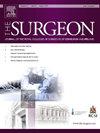Needlestick injury incidence and reporting in Irish surgical trainees
IF 2.3
4区 医学
Q2 SURGERY
Surgeon-Journal of the Royal Colleges of Surgeons of Edinburgh and Ireland
Pub Date : 2025-03-06
DOI:10.1016/j.surge.2025.02.011
引用次数: 0
Abstract
Introduction
Needlestick injuries (NSI) in healthcare workers are common and rising in Ireland. Surgical trainees are particularly at-risk of NSIs. The aim of this study was to assess the estimated NSIs suffered by Irish surgical trainees, the reporting behaviours of NSI and the perceived barriers to reporting.
Methods
This was an anonymous, online survey of surgical trainees on the Irish surgical training programmes. Trainees were asked the estimated NSIs ever received, perceived NSI contributing factors, NSIs reported to occupational health, and perceived barriers to reporting of NSIs. Independent predictors of needlestick injury were assessed by ordinal logistic regression. Data analysis was performed with R, version 4.1.1.
Results
There were 73 participants, with 66 % male and a median age group of 30–34 years. The median year of surgical training was 4. All but one trainee reported an NSI prior, with the median 6 (range of 0 to over 20). On ordinal logistic regression, year of training was the only independent factor associated with greater reported NSIs (OR 1.32). Most NSIs were from a suture needle in the non-dominant hand. Time pressure (79%) and mental fatigue (78%) were the most frequently perceived contributory factors. Only 14% of participants report all NSIs. The time requirements (82%) and reporting pathway complexity (81%) were the primary listed reasons for non-reporting of NSIs.
Conclusion
Despite being at high risk of needlesticks and the associated risks, few surgical trainees report all needlestick injuries. Reporting pathways of needlestick injuries should be streamlined to encourage greater reporting.
爱尔兰外科实习生针刺损伤发生率及报告。
简介:针刺伤(NSI)在卫生保健工作者是常见的和上升在爱尔兰。外科培训生特别容易发生nsi。本研究的目的是评估爱尔兰外科受训者遭受的估计自伤,自伤的报告行为和报告的感知障碍。方法:对爱尔兰外科培训计划的外科学员进行匿名在线调查。受训者被问及曾经收到的估计的自伤、感知到的造成自伤的因素、向职业健康报告的自伤以及感知到的报告自伤的障碍。针刺伤的独立预测因素采用有序逻辑回归进行评估。使用R 4.1.1版本进行数据分析。结果:共有73名参与者,其中66%为男性,中位年龄30-34岁。手术培训的中位数为4年。除一名受训者外,所有受训者均报告有自伤,中位数为6(范围从0到20以上)。在有序逻辑回归中,培训年份是唯一与较高报告的nsi相关的独立因素(OR 1.32)。大多数nsi是由非优势手的缝合针引起的。时间压力(79%)和精神疲劳(78%)是最常见的诱因。只有14%的参与者报告了所有的nsi。时间要求(82%)和报告途径复杂性(81%)是未报告nsi的主要原因。结论:尽管有较高的针刺风险和相关风险,但很少有外科实习生报告所有针刺损伤。应简化针刺伤的报告途径,以鼓励更多的报告。
本文章由计算机程序翻译,如有差异,请以英文原文为准。
求助全文
约1分钟内获得全文
求助全文
来源期刊
CiteScore
4.40
自引率
0.00%
发文量
158
审稿时长
6-12 weeks
期刊介绍:
Since its establishment in 2003, The Surgeon has established itself as one of the leading multidisciplinary surgical titles, both in print and online. The Surgeon is published for the worldwide surgical and dental communities. The goal of the Journal is to achieve wider national and international recognition, through a commitment to excellence in original research. In addition, both Colleges see the Journal as an important educational service, and consequently there is a particular focus on post-graduate development. Much of our educational role will continue to be achieved through publishing expanded review articles by leaders in their field.
Articles in related areas to surgery and dentistry, such as healthcare management and education, are also welcomed. We aim to educate, entertain, give insight into new surgical techniques and technology, and provide a forum for debate and discussion.

 求助内容:
求助内容: 应助结果提醒方式:
应助结果提醒方式:


